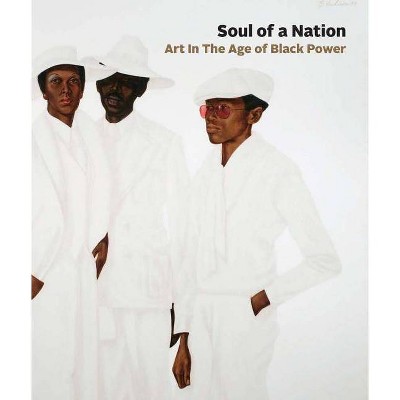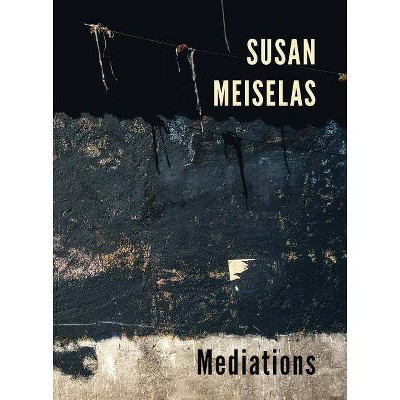Soul of a Nation - by Mark Godfrey & Zoé Whitley (Hardcover)

Similar Products
Products of same category from the store
AllProduct info
<p/><br></br><p><b> About the Book </b></p></br></br>In the period of radical change that was 1963-1983, young black artists at the beginning of their careers in the USA confronted key questions and pressures. How could they make art that would stand as innovative, original, formally and materially complex, while also making work that reflected their concerns and experience as black Americans? This publication surveys this crucial period in American art history, bringing to light previously neglected histories of twentieth-century black artists including Sam Gilliam, Melvin Edwards, Jack Whitten, William T. Williams, and Frank Bowling.<p/><br></br><p><b> Book Synopsis </b></p></br></br><p><strong>African American art in the era of Malcolm X and the Black Panthers</strong></p><p>In the period of radical change that was 1963-83, young black artists at the beginning of their careers confronted difficult questions about art, politics and racial identity. How to make art that would stand as innovative, original, formally and materially complex, while also making work that reflected their concerns and experience as black Americans? </p><p><i>Soul of a Nation</i> surveys this crucial period in American art history, bringing to light previously neglected histories of 20th-century black artists, including Sam Gilliam, Melvin Edwards, Jack Whitten, William T. Williams, Howardina Pindell, Romare Bearden, David Hammons, Barkley L. Hendricks, Senga Nengudi, Noah Purifoy, Faith Ringgold, Betye Saar, Charles White and Frank Bowling.</p><p>The book features substantial essays from Mark Godfrey and Zoe Whitley, writing on abstraction and figuration, respectively. It also explores the art-historical and social contexts with subjects ranging from black feminism, AfriCOBRA and other artist-run groups to the role of museums in the debates of the period and visual art's relation to the Black Arts Movement. Over 170 artworks by these and many other artists of the era are illustrated in full color.</p><p>2017 marks the 50th anniversary of the first use of the term "black power" by student activist Stokely Carmichael; it will also be 50 years since the US Supreme Court overturned the prohibition of interracial marriage. At this turning point in the reassessment of African American art history, <i>Soul of a Nation</i> is a vital contribution to this timely subject.</p><p/><br></br><p><b> Review Quotes </b></p></br></br><br>The OG Soul of a Nation book, which chronicles work created by Black artists from 1963-1983...focuses on the art of the time, much of which wrestled with questions about racial identity and politics and what it means to be Black in America... and gives context to a unique moment in history.--Tembe Denton-Hurst "New York Magazine"<br><br>...a deeply wonderful, playful, and moving collection of images and text that prove her achievement of something seemingly impossible: photographing the invisible.-- "Elle"<br><br>Portrays the art of the civil rights era not simply as an index of revolutionary political projects or desires, but as a revolution in and of itself.-- "Cultured"<br><br>Soul of a Nation surveys 1963-83, the crucial period in American art history, bringing to light previously neglected histories of 20th-century Black artists.--Marcellas Reynolds "Essence"<br><br>The new survey of work made in two tumultuous decades of black activism reveals a prodigious range of artistic expression.-- "The Financial Times"<br><br>The Black Power movement was more than just a protest group; it was a watershed moment in American history and a coming-together of enormous importance and influence -- not just socially and politically, but culturally and artistically as well.-- "CNN"<br><br>...a sweeping look at how artists of the time responded to ideas about black identity, political activism and social responsibility.--Roslyn Sulcas "New York Times"<br><br>...a visual journey through the period with documentary photographs and full-color images of art and ephemera.... The curators expound upon a score of topics, from the Studio Museum in Harlem, Just Above Midtown Gallery, The Black Photographers Annual, and Emory Douglas and the Black Panther newspaper to abstraction shows, black women artists, FESTAC '77, and the Wall of Respect and mural movement.--Victoria L. Valentine "Culture Type"<br><br>...an intense, transformative period in American art, activism, and culture, when black identity came into sharper focus and demanded to be reckoned with, while the spark of black liberation caught fire in the US, the Caribbean, and Africa.--Cheryl Finley "Artforum"<br><br>..impresssive feat of research, presenting and contextualizing many artists who never became household names.--Sara Christoph "Bookforum"<br><br><i>Soul of a Nation</i> is a must-read for anyone interested in the history of American art and the importance of black artists in that history. The book is both a record and a revelation, making the presence of African-American artists acutely visible in tandem with the radical changes that occurred in art and politics from the 1960s to the 1980s.--Andria Hickey "New York Magazine"<br><br><i>Soul of a Nation</i> is a significant and transformative contribution to art history - and American history. Richly informative and deeply engaging, this volume documents the powerful role black artists had in shaping contemporary art and our society at a pivotal moment in history. It is sure to be a profoundly valuable resource ... for decades to come.--Thelma Golden "The Studio Museum"<br><br>[the] story of the radical, brilliant and hugely varied art made by African American artists in the political and cultural landscape of Civil Rights, Black Panthers, Blaxploitation, and other manifestations of the fight for equality in education, jobs and representation.... a diversity of aesthetics, ideas and ambition.--Pernilla Holmes "Frieze"<br><br>[A] big, beautiful, passionate show of art.--Holland Cotter "New York Times"<br><br>A masterful catalogue published by the Tate/D.A.P., which features substantial essays that provide much-needed insights into this vastly underserved and broadly neglected period of art history.... a tour-de-force, --Miss Rosen "Crave"<br><br>A sweeping look at how artists of the time responded to ideas about black identity, political activism and social responsibility.--Roslyn Sulcas "New York Times"<br><br>At London's flagship modern art gallery, Tate Modern, one of this summer's most lauded exhibitions features work by African-American artists made in the age of Martin Luther King Jr. Yet, while "Soul of a Nation" is nominally a historical display, gallery goers spilling out of the show this week found an obvious contemporary resonance to the art they had just seen.--Patrick Kingsley "New York Times"<br><br>Civil rights meet aesthetics in this riveting survey of 20 crucial years of black American art and struggle ... uncovers an entire lost history of American art.--Jonathan Jones "The Guardian"<br><br>Each piece in the exhibit is not so much a representation of the movement as they are physical artifacts of the revolution itself.--Taylor Hosking "Vice"<br><br>Groundbreaking.--Victoria L. Valentine "Culture Type"<br><br>In these works, and in countless others, is the power of art to uplift, showcase, describe and demonstrate the black experience - sometimes in uncomfortable but entirely necessary, vital ways.--Belle Hutton "AnOther"<br><br>It's black and it's beautiful.--Alexandra Simon "Brooklyn Daily"<br><br>Learn about the artists who didn't leave the same legendary mark as Jean-Michel Basquiat, but who made an impact on black feminism, AfriCOBRA, and other artist-run groups. Delve deep into the role of museums in the debates of the period, and visual art's relation to the Black Arts Movement.--Natasha Gural "Forbes"<br><br>More than 60 [black artists] appear in this big, beautiful, passionate show of art that functioned as seismic detector, political persuader and defensive weapon.--Holland Cotter "The New York Times"<br><br>Radiant and radical...defining the soul of black art.--Holland Cotter "The New York Times"<br><br>Soul of Nation captures a shift in how black people used art in the fight for liberation. Artists were no longer satisfied with pain being seen; they wanted it to be felt.--André Wheeler "The Guardian"<br><br>Successfully layering a broader socio-historical narrative onto a period of radical non-conformity, this is an important show, now.--Osei Bonsu "Frieze.com"<br><br>The Aspirations of a Generation of Black Artists Visualized in Soul of a Nation.--Daniel Gerwin "Hyperallergic"<br><br>This is a celebration of the work of Black American artists in the 1960s and 1970s. While the art on display is inspired by the mass Civil Rights Movement in the US during that time it is incredibly poignant that the issues raised remain so relevant today.--Theresa Bennett "Socialist Review"<br><br>This is a rich, absorbing and thought-provoking exhibition with enough themes and ideas to power three shows its size ... this is an epic response to an epic subject and without doubt one of the shows of the year.--Mark Hudson "The Telegraph"<br><br>This powerful work of documentary photography captures the momentum of the civil rights movement through one of its lesser known demonstrations.--Nell Irvin Painter "New York Review of Books"<br>
Price History
Cheapest price in the interval: 32.49 on October 22, 2021
Most expensive price in the interval: 32.49 on December 20, 2021
Price Archive shows prices from various stores, lets you see history and find the cheapest. There is no actual sale on the website. For all support, inquiry and suggestion messagescommunication@pricearchive.us




















